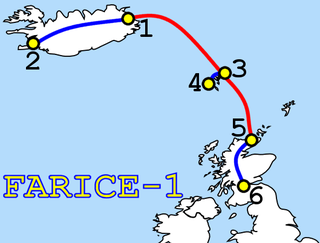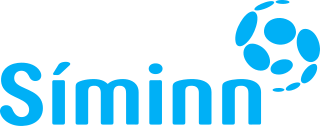
The economy of the Faroe Islands was the 166th largest in the world in 2014, having a nominal gross domestic product (GDP) of $2.613 billion per annum. GDP increased from DKK 8 billion in 1999, to 21 billion in 2019. The vast majority of Faroese exports, around 90%, consists of fishery products.
Telephones - main lines in use: 22,000 (1995)
Telecommunications in Iceland is a diversified market.

FARICE-1 is a submarine communications cable connecting Iceland, the Faroe Islands and Scotland. The cable has been in use since January 2004 and is 100% owned by the Icelandic state. The cable had an initial design capacity of 720 Gbit/s and is a two fibre pair design. The length of the cable is 1205 km for the direct route between Iceland and Scotland. The cable structure and repeaters were made by Pirelli and the terminal equipment was supplied by TYCO. In the year 2013 the terminal equipment was upgraded by Ciena bringing the total capacity of the submarine cable to 11 Tbit/s. The cable has service access points in Reykjavik and Keflavik Airport as well as in London Telehouse East. The company Farice ehf sells services over the FARICE-1 cable. FARICE-2 was never built. DANICE is the complementary submarine cable.
The Faroese mass media consists of several newspapers, radio stations, magazines, as well as a local TV station, Kringvarp Føroya.

Síminn hf., previously named Landssíminn and Póstur og Sími, is an Icelandic telecommunications company. It offers communication services for both private and corporate clients, including mobile (2G/3G/4G/5G), landline (VoIP/POTS), Internet (ADSL/VDSL/FTTH) and IPTV services. Síminn also operates multiple TV channels and streaming services. Síminn is listed on the Icelandic stock exchange.
VSNL International Canada or Tata Communications (Canada) ULC is an international telco carrier. The company is a subsidiary of Tata Communications, part of India's Tata Group and based in Montreal, Quebec. Part of their recent work has involved the updating of the CANTAT transatlantic cable system that connects the United Kingdom and Newfoundland under the Atlantic Ocean. The latest version of CANTAT, CANTAT-3, had a capacity of 5 Gbit/s in each direction across the Atlantic.
Pennant Point is a rural community located at the head of Pennant Harbour near Sambro on the Chebucto Peninsula in the Halifax Regional Municipality Nova Scotia on Route 349.
Vodafone Iceland is an Icelandic telecommunications company owned by Sýn. Although the company carries the Vodafone brand and trademark, Vodafone Group owns no interest in the company, but rather franchises the brand and associated advertising styles.
CANTAT is an acronym for Canada TransAtlantic Telephone Cable, a series of submarine communications cable systems linking Canada with the U.K. and later Europe. The first cable was a joint venture of Cable & Wireless and the Canadian Overseas Telecommunications Corporation (COTC) implementing national policies to establish a Commonwealth Round the World Cable System. The name has been applied to three systems.
Television in Iceland is currently composed of the public broadcasting service of RÚV, five free-to-view channels and a number of subscription channels provided by private broadcasters. Broadcasts began in 1955 when the American Forces Radio and Television Service (AFRTS) started an English-language television service broadcasting from Naval Air Station Keflavik, which operated until 2006. The first Icelandic-language television broadcasts started in September 1966 with the launch of RÚV, originally called Sjónvarpið. In 1986 the first privately owned TV station, Stöð 2, began broadcasts. In recent years the emergence of foreign internet streaming services such as Netflix and Disney+ has seen shift from domestic providers provide similar on demand streaming services such as Síminn Premium and Stöð 2+.

The use of the Internet in Iceland places Iceland among the top countries in the world in terms of Internet deployment and use. The use of internet in Iceland is widespread. Iceland has been at the forefront of adopting new internet access technologies starting in the early 1990s with dial-up connections. Today, 1Gbit/s speeds are available to 90% of citizens through full-fibre networks. Iceland has 60.2Tb/s of submarine bandwidth capacity through 3 cables.
SHEFA-2 is an undersea communication cable linking the Faroe Islands to mainland Scotland via the Northern Isles. It is named after the route on which it is being deployed (SHEtland-FAroes) and succeeds an earlier cable called SHEFA-1 on the same route.

Greenland Connect is a submarine communications cable system that connects Canada, Greenland, and Iceland. The cable contains two fibre pairs specified for 128*10 Gbit/s wavelength each. Initial lit capacity is 1*10 Gbit/s for each fibre pair. Two additional 10 Gbit/s Wavelength were installed in the summer of 2010. The cable has cable landing points at:

The DANICE submarine communications cable system transits 2250 km of the North Atlantic Ocean and the North Sea to connect Iceland and Denmark. It consists of four fibre pairs, capable of carrying in total up to 36.4 Tbit/s of data using 100Gbit/s coherent wavelength technology available in 2013. The cable went into operation in November 2009 and has had no submarine faults. The operator of the cable is Farice ehf. The complementary cable is FARICE-1. DANICE has cable landing points at:

Gulf Bridge International (GBI) is the Middle East's first privately owned submarine cable system linking the countries bordering the Persian Gulf on a self-healing ring to each other and onwards to Europe, Africa and Asia. Gulf Bridge International (GBI), both owns and operates this submarine cable asset as a carrier's carrier as well as offering a full suite of wholesale transmission, IP capacity options, and Enterprise Services. Its main headquarters are located at the Qatar Science & Technology Park in Doha, Qatar.
Farice is a telecommunications service provider operating in Iceland. The company offers Internet transit, MPLS VPN, DWDM and SDH services and offers only international connectivity. The company operates mainly as a carrier for service providers, data center customers and data center service providers.
Energy in the Faroe Islands is produced primarily from fossil fuels, with further contributions from hydro and wind power. Oil products are the main energy source, mainly consumed by fishing vessels and sea transport. Electricity is produced by oil, hydropower and wind farms, mainly by SEV, which is owned by all the municipalities of the Faroe Islands. The Faroe Islands are not connected by power lines with continental Europe, and thus the archipelago cannot import or export electricity.
Føroya Tele P/f (FT) is the public telecommunications company in the Faroe Islands. It is one of the largest companies in the country with 230 employees and an annual turnover of around 40 million euros. The head office is in Tórshavn Municipality.






